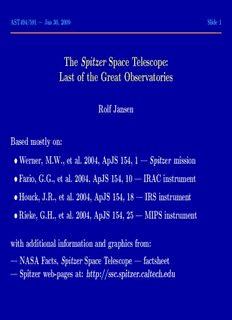
Space Telescope: Spitzer The Last of the Great Observatories PDF
Preview Space Telescope: Spitzer The Last of the Great Observatories
AST494/591 — Jan 30, 2009 Slide 1 The Spitzer Space Telescope: Last of the Great Observatories Rolf Jansen Based mostly on: • Werner, M.W., et al. 2004, ApJS 154, 1 — Spitzer mission • Fazio, G.G., et al. 2004, ApJS 154, 10 — IRAC instrument • Houck, J.R., et al. 2004, ApJS 154, 18 — IRS instrument • Rieke, G.H., et al. 2004, ApJS 154, 25 — MIPS instrument with additional information and graphics from: — NASA Facts, Spitzer Space Telescope — factsheet — Spitzer web-pages at: http://ssc.spitzer.caltech.edu AST494/591 — Jan 30, 2009 Slide 2 Outline • What? • Why? • When? • How? • What? • What? • How? • Wow! AST494/591 — Jan 30, 2009 Slide 3 Outline • What — is NASA’s orbiting Great Observatories program? • Why — do we need coverage at multiple wavelengths, from space? • When — or a bit of history of the field, particularly IRAS • How — does Spitzer differ from IRAS? • What — is Spitzer contributing? • What — instruments does Spitzer contain? • How — do these perform? • Wow — pretty pics! AST494/591 — Jan 30, 2009 Slide 4 NASA’s orbiting Great Observatories program • Four observatories, each accessing different wavelength regime – Hubble Space Telescope (HST): UV–optical–near-IR – Compton Gamma-Ray Observatory (CGRO): γ-rays – Chandra X-ray Observatory (Chandra): X-rays – Spitzer Space Telescope (Spitzer): mid-IR–far-IR AST494/591 — Jan 30, 2009 Slide 5 NASA’s orbiting Great Observatories program • Overlap between operational mission life: expected synergy – HST: 1990–present – CGRO: 1991–1999 (de-orbited) – Chandra: 1999–present – Spitzer: cold mission 2003–2009, warm mission 2009–?? AST494/591 — Jan 30, 2009 Slide 6 Why multiple wavelengths? AST494/591 — Jan 30, 2009 Slide 7 Why multiple wavelengths? Ground-based visual and IRAS infrared images of Orion AST494/591 — Jan 30, 2009 Slide 8 Why not from the ground? AST494/591 — Jan 30, 2009 Slide 9 Why not from the ground? AST494/591 — Jan 30, 2009 Slide 10 A bit of history: the InfraRed Astronomical Satellite
Description: